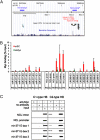Stem cell-like micro-RNA signature driven by Myc in aggressive liver cancer
- PMID: 21059911
- PMCID: PMC2996672
- DOI: 10.1073/pnas.1009009107
Stem cell-like micro-RNA signature driven by Myc in aggressive liver cancer
Abstract
Myc activation has been implicated in the pathogenesis of hepatoblastoma (HB), a rare embryonal neoplasm derived from liver progenitor cells. Here, microRNA (miR) expression profiling of 65 HBs evidenced differential patterns related to developmental stage and Myc activity. Undifferentiated aggressive HBs overexpressed the miR-371-3 cluster with concomitant down-regulation of the miR-100/let-7a-2/miR-125b-1 cluster, evoking an ES cell expression profile. ChIP and Myc inhibition assays in hepatoma cells demonstrated that both miR clusters are regulated by Myc in an opposite manner. We show that the two miR clusters exert antagonistic effects on cell proliferation and tumorigenicity. Moreover, their combined deregulation cooperated in modulating the hepatic tumor phenotype, implicating stem cell-like regulation of Myc-dependent miRs in poorly differentiated HBs. Importantly, a four-miR signature representative of these clusters efficiently stratified HB patients, and when applied to 241 hepatocellular carcinomas (HCCs), it identified invasive tumors with a poor prognosis. Our data argue that Myc-driven reprogramming of miR expression patterns contributes to the aggressive phenotype of liver tumors originating from hepatic progenitor cells.
Conflict of interest statement
The authors declare no conflict of interest.
Figures





Comment in
-
The almighty MYC: orchestrating the micro-RNA universe to generate aggressive liver cancer.J Hepatol. 2011 Aug;55(2):486-7. doi: 10.1016/j.jhep.2011.01.042. Epub 2011 Feb 22. J Hepatol. 2011. PMID: 21349304 No abstract available.
-
microRNAs and the MYC network: a major piece in the puzzle of liver cancer.Gastroenterology. 2011 Jun;140(7):2138-40. doi: 10.1053/j.gastro.2011.04.023. Epub 2011 Apr 22. Gastroenterology. 2011. PMID: 21515272 No abstract available.
References
-
- Bartel DP. MicroRNAs: Genomics, biogenesis, mechanism, and function. Cell. 2004;116:281–297. - PubMed
Publication types
MeSH terms
Substances
Associated data
- Actions
Grants and funding
LinkOut - more resources
Full Text Sources
Other Literature Sources
Medical
Molecular Biology Databases

